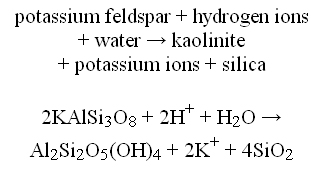Joshua Tree National Park Geology
Sculpturing the Landscape
Weathering
One of the most impressive aspects of the landforms in the Joshua Tree region is the strange and picturesque shapes assumed by the bold granitic rock masses at the Wonderland of Rocks, Ryan Campground, Split Rock, and elsewhere in the area (Photos 11, 12). The sculpturing of these rock masses results from the combined action of rock jointing and chemical and mechanical weathering. The combination of these processes is called spheroidal weathering, the spalling-off of thin concentric shells of rock to form spherical rock masses. Spheroidal weathering results from slight pressures that have been built up in the outer portions of the rock from chemical decomposition along joint surfaces. It is the chemical decomposition of the aluminum silicate minerals that is primarily responsible for these pressures. For example, when potassium feldspar comes into contact with hydrogen ions and water, the following chemical reaction takes place:
Photo 12. View of Lost Horse Valley from the Lost Horse Mountains. The flat surface is a pediment and the rocky knobs are inselbergs, remains of the corestones which were isolated in ages past by deep chemical weathering of the White Tank quartz monzogranite. The foreground hills are underlain by the dark Pinto Gneiss.
The potassium ions and silica are dissolved in water and eventually carried away by surface runoff or by ground water, leaving behind the clay. The clay mineral that has been formed is called kaolinite, and it occupies a greater volume than the original feldspar. This increase in volume is responsible for the pressure that causes the outer part of the cuboidal blocks of rock to expand. The expansion is especially great at the edges and corners so that gradually the blocks of rock lose their sharp edges and eventually assume a rounded or spheroidal shape.
The stresses, in addition to the popping off of thin shells of rock, cause the mineral grains of the rock to disintegrate mechanically and form a loose mineral soil called grus.
Frost and root wedging contribute to the breakdown of rocks by mechanical action. When water seeping into cracks and joints in the winter months freezes, it expands by 10 percent and breaks the rocks. Plant roots, anchored in a hairline crack or a joint, will slowly expand and enlarge the crack as the plant grows.
The concave hollows and pits that are common on joint surfaces in crystalline rocks form by a process called cavernous weathering. This process begins with local irregularities or perhaps temporary accumulations of mineral fragments that hold water on the rock surface. The additional moisture locally promotes kaolinization of feldspars and other aluminum silicate minerals on the surface. Once a concavity begins to develop it perpetuates itself by ponding water from rainfall, melting snow, or even dew. Furthermore, the shade provided by the concavity assists chemical decay by reducing water loss from evaporation and also provides a suitable habitat for lichen. Lichen produces organic acids which furthers the process of chemical decomposition. Loose mineral grains so produced are removed by rainwash or wind.
The undercutting of vertical surfaces, common on the shady sides of rock outcroppings throughout the Monument, have formed in a similar manner to cavernous weathering by the action of moisture trapped in the soil at the base of the vertical surface. Such undercutting probably accounts for many of the steep cliff faces as the processes of wearing back and rounding off higher up on the cliff cannot keep up with the undercutting at the base.
Good examples of cavernous weathering and undercutting exist at many places in the Monument. Skull Rock is an example of undercutting and cavernous weathering (Photo 13).
Photo 13. Skull Rock at Jumbo Rocks illustrates cavernous weathering and undercutting by subsoil notching.
Erosion
Erosion is the dynamic process that lifts up, carries away, and deposits surficial rock material. Running water, even in arid environments, is by far the most important erosional agent. Wind action is important in the desert, but the long range effects of the wind are small when compared to the action of running water.However, weathering and erosional processes presently operating in the arid conditions of the Joshua Tree region apparently are not entirely responsible for the spectacular sculpturing of the rocks of the region. The present Joshua Tree landscape, and that of much of the Mojave Desert, is essentially a collection of relict features inherited from earlier times of higher rainfall and lower temperatures. Thus, the desert landscape is dominantly a "fossil" landscape. For example, Fortynine Palms Canyon could not have formed in the present rainfall regime. Such deep canyons are attributed to former pluvial conditions (Bradshaw and others, 1978, p. 305) during an epoch when the area of the southwestern United States received approximately eighty percent greater precipitation than at present, the evaporation was about thirty percent less, and the mean annual temperature was 5°-8°C cooler (Flint, 1971, p. 442-451).